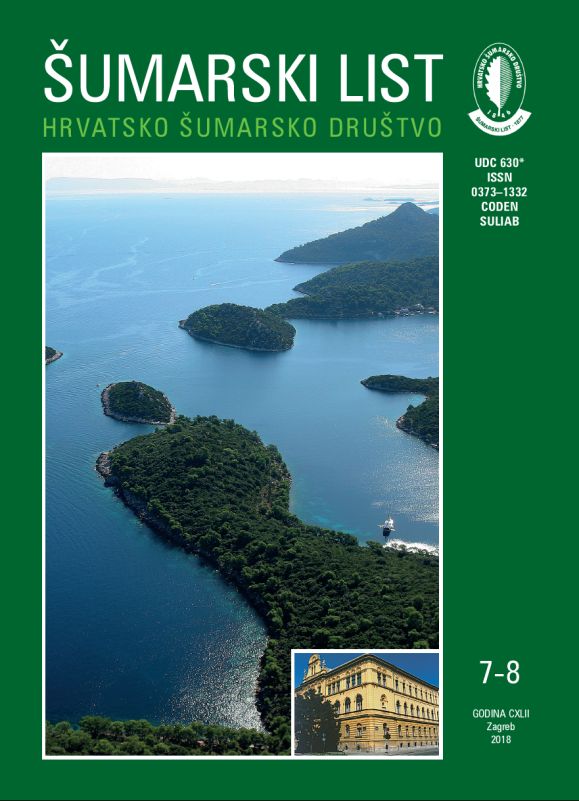
broj: 7-8/2018
pdf (15,28 MB) |
|
||||||||||||||
| RIJEČ UREDNIŠTVA | ||
| Uredništvo | ||
| FORESTS IN THE LIGHT OF THE NEW FOREST ACT pdf HR EN | 349 | |
| IZVORNI ZNANSTVENI ČLANCI | ||
| Mladen Ognjenović, Ivica Čehulić, Ante Kaliger, Maja Križanec, Anamarija Laslo, Ivan Seletković, Nenad Potočić | UDK 630* 114 (001) https://doi.org/10.31298/sl.142.7-8.1 | |
| The influence of soil conditioner „Herbafertil“ on the growth and development of amur maple (Acer tataricum L. ssp. ginnala Maxim.) in a nursery trial pdf HR EN | 351 | |
| Violeta Dimitrova | UDK 630* 537 (001) https://doi.org/10.31298/sl.142.7-8.2 | |
| Stocks of dead biomass of beech (Fagus sylvatica L.) forest ecosystems in West Balkan Range, Bulgaria pdf HR EN | 363 | |
| Michal Bugala, Zuzana Parobeková, Ján Parobek | UDK 630* 180 + 564 (001) https://doi.org/10.31298/sl.142.7-8.3 | |
| Influence of the ecological conditions on the productive potential of Grey alder pdf HR EN | 371 | |
| PRETHODNO PRIOPĆENJE | ||
| Zdravko Dolenec | UDK 630* 148.2 + 111 https://doi.org/10.31298/sl.142.7-8.4 | |
| Results of long-term monitoring of timing of laying in deciduous forest Blue tit (Cyanistes caeruleus L.) in northwestern Croatia pdf HR EN | 381 | |
| Ebubekir Gündogdu | UDK 630* 451 + 153 https://doi.org/10.31298/sl.142.7-8.5 | |
| A new location record of European polecat (Mustela putorius L.) from northeastern forests in Turkey pdf HR EN | 387 | |
| PREGLEDNI ČLANCI | ||
| Martina Đodan, Robert Brus, Anne-Mareen Eisold, Valeriu-Norocel Nicolescu, Milan Oršanić, Kristina Pratasiene, Sanja Perić | UDK 630* 181.5 https://doi.org/10.31298/sl.142.7-8.6 | |
| Non-native tree species in the viewpoint of climate change: chances and opportunities - Croatia as a case study pdf HR EN | 391 | |
| Summary The management of tree species non-native to Republic of Croatia has a certain tradition within Croatian forest management practice; nowadays, their potential should be regarded and re-evaluated in the new frame of climate changes and growing society demands for forest products and services. This paper is a contribution to non-native tree species (NNTS) introduction and use in Croatia, aiming at providing state of the art of NNTS as well as overview of studies and examples of possible management opportunities. Because of the complexity of the matter and growing need to further investigate risks and challenges of NNTS in Croatia, authors have continued their research and will publish the results in a separate paper. Amount of the area occupied by NNTS forest cultures point to the conclusion that the use of these tree species in forest practice is not reached by far and the nursery production does not back up the need for NNTS use. Paper also provides a comprehensive overwiev of different aspects and benefits of the use of NNTS in Croatia. For example, increased wood production and non-wood forest products; production of high quality timber in short–time periods; use of fast-growing tree species for bioenergy production in higher proportion and enhancement of ecosystem services. Increase of stability and adaptive capacity of forest stands by the use of NNTS is highlighted as new silvicultural option for facing climate change. Their use in reforestation or conversion of degraded forest to more valuabe and more resistant/resilient stands offers new possibilities. Integrated and site-specific management is a strategy, which seems to be an appropriate approach for guidelines for the introduction and management of NNTS in Croatia. The use of high productive, resistant NNTS presents new silvicultural solution especially important in terms of site amelioration and enhancement of resistance and resilience of forest stands, which is the most important component of adaptive forest management strategies. Key words: new silvicultural options; adaptation strategies; forest landscape restoration. | ||
| Markéta Špaková, Božena Šerá | UDK 630* 174 + 272 https://doi.org/10.31298/sl.142.7-8.7 | |
| Woody plants of the main part of the Bečov Botanical Garden pdf HR EN | 403 | |
| STRUČNI ČLANCI | ||
| Darko Posarić, Stjepan Nikolić | UDK 630* 582 https://doi.org/10.31298/sl.142.7-8.8 | |
| Establishment of a network of haulage tracks and silvicultural trails in Pedunculate oak forests as a way of more efficient stand tending and more efficient forest exploitation pdf HR EN | 411 | |


